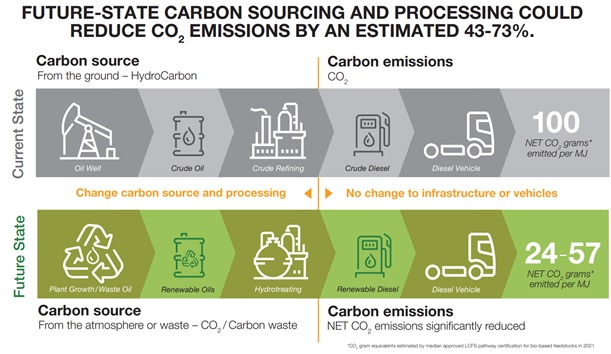In the first two articles of this series, we covered why hydrogenation-derived renewable diesel (HDRD) is gaining market adoption and examined multiple test results that explain the need for multifunctional diesel fuel additives in HDRD.
In this third article, we’ll look at:
- HDRD’s role in meeting both short-term and long-term carbon intensity (CI) reduction targets
- How HDRD can make it easier to meet increasingly stringent emissions requirements
First, a quick recap:
HDRD Offers Benefits Beyond Conventional Fossil Fuels, Though There Are Challenges
HDRD – or HVO (hydrogenated vegetable oil) as it is also commonly known – is an increasingly mature direct drop-in for ultra-low sulfur diesel (ULSD).
It offers many notable benefits, including a high natural cetane number, good low-temperature operability with winter grades, potential for lower emissions, reduced injector deposit formation and greater oxidation stability.
However, HDRD, like ULSD, isn’t without challenges. And it is for the reasons noted in the articles mentioned above that we believe HDRD should be treated with appropriate additives to protect fleets and consumers alike.
Using HDRD Significantly Reduces Carbon Intensity and Enables Emissions Reduction Targets
Nonetheless, HDRD and its many benefits still present compelling options for addressing many modern-day commercial issues, including reduced carbon intensity (CI) and net emissions output.
What is Carbon Intensity?
The CI of a fuel represents the amount of CO2-equivalent emissions per energy provided by the fuel, taking into account the emissions and energy consumption needed to make the fuel, distribute it, and power a vehicle (also known as “well-to-wheel”). California’s Low Carbon Fuel Standard (LCFS) is the leading example of how to rapidly expand the use of low-carbon, sustainable fuels through their CI certification and credit system.
The figure below uses average values from current LCFS certified pathways to show how HDRD can significantly reduce net carbon emissions compared to ULSD.

HDRD, because of differentiated sourcing and processing approaches versus conventional fossil fuel sourcing and processing, significantly reduces net carbon emissions.
How Does HDRD Enable Hardware to Meet More Stringent Emissions Requirements
HDRD combustion simultaneously results in lower NOx, particulates and other emissions compared to ULSD. The reduced emissions decrease the loading on vehicle exhaust aftertreatment devices, improving their reliability.
The Future is Calling: Growing Demand and Capacity for Renewable Fuels
Given these advantages, it’s logical to expect HDRD to become more prevalent among fleets and passenger vehicles, especially amidst evolving regulations (e.g., the U.S. EPA’s GHG Phase 2 Regulations and Clean Truck Initiative, the California Air Resources Board’s low-emission vehicle program, China IV, Euro 7, etc.) and the realization that electric- and hydrogen-powered vehicles will take time to gain adoption during the coming decades.
Commercial demand is also evidenced by recent strategic investments among oil majors to support renewable fuel production, including efforts to ramp up production of sustainable aviation fuel (SAF). A renewable diesel co-product that acts as a low-carbon-intensity alternative to petroleum-based aviation fuel, SAF offers compelling value to the airline industry as combustion-free aviation technology (though it is not yet feasible on a commercial level.)
Our View
HDRD will remain a compelling substitute for fossil fuels in both the short- and long-term. Among the many benefits, the significant reduction in net carbon emissions of renewable fuels bodes well for the environment as alternative technologies will take time to gain prevalence in the market.
With that in mind, however, it’s critically important to focus on the here and now in reducing emissions and enabling future fuels to deliver what is needed considering the full picture (including the impacts of LCA). Equally important is an in-depth understanding of the role additive technology will play in this space in the coming years.
In the short-term, and at a minimum, we recommend that renewable diesel producers treat fuel with additives capable of mitigating potential stability and deposit issues.









